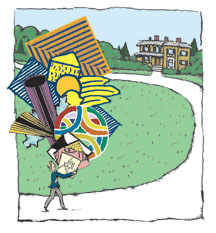
|
October 24, 2007: On the Campus
(Illustration: Daniel Baxter; Photos below: Hyunseok Shim ’08) |
New art, new college
 By
Jocelyn Hanamirian ’08
By
Jocelyn Hanamirian ’08
When Shirley Tilghman was selected as Prince-ton’s president in 2001 and began thinking about moving into the president’s residence at Lowrie House, one thing became clear: She would have to redecorate.
“After all, this is a University that grows with the times, and I couldn’t think of a reason why Lowrie House shouldn’t change with the times,” Tilghman said.
So Tilghman — who also wanted a new look for her Nassau Hall office — did what any student looking to bring comfort to a new space would do: She checked out the U-Store’s, er, the University Art Museum’s, collection of paintings. Her selections perhaps can be best described as the meeting of a scientist’s sensibilities with the impulse to innovate while retaining a sense of propriety and respect for the space. There is a Roy Lichtenstein in her office, and a Frank Stella ’58 and an Ellsworth Kelly in her home.
These modern-art heavy hitters are among the nearly 20 pieces on loan from the museum collection that Tilghman is proud to display in some of the University’s most traditional spaces. In her office, Tilghman looks out onto an untitled Lichtenstein painting from 1997, a still life splashed with newspaper-print-like blue, yellow, and black dots.
“I love abstraction and color. I think this is one of the things I probably didn’t realize before I went to choose art for this office and Lowrie House,” Tilghman said. “I’m a scientist so I like angles, I like cleanness.”
Museum assistant curator Calvin Brown helped Tilghman make her choices, though she said that it “probably doesn’t hurt” that her daughter, who graduated from Princeton in 2003, majored in art history and is a graduate student in modern art.
Tilghman’s taste is not limited to the abstract, however. She
recently selected paintings by American artists Andrew Wyeth, Winslow
Homer, and George Inness for the reception room outside her office. The
paintings are rotated between public display and storage, meaning Tilghman’s
rooms are updated continuously. “It’s always very painful
to give them up,” she said. ![]()
 By
Bianca Bosker ’08
By
Bianca Bosker ’08
The $136 million, 250,000-square-foot Whitman College rises out of perfectly manicured green lawns and just-planted trees, its stone façade sparkling in the late-September sun. For different Princetonians, the dorm evokes a Disney castle, a mausoleum, or a cathedral, but most are thrilled with its collegiate gothic look.
“It really balances the campus out because before we had gothic up campus, and now we have gothic down campus as well,” said sophomore Ashley Schoettle. “That’s one of the things that drew me to Princeton: I loved the architecture.”
While Whitman may resemble Princeton’s early-20th-century dorms, it’s anything but old-fashioned. Along with air conditioning, a 65-seat theater, flat-screen TVs in the dining hall, and digital photo labs, there are a study room, common room, kitchen, and laundry room for every hallway.
In Whitman’s dining hall, gone are the long wooden tables typical of Princeton’s cafeterias, replaced by booths and small, round tables. This switch has led to a seating crunch during mealtimes and some grumbling among students. “The new seating system is inefficient,” said Joelle Birge ’11. “Big, long [tables] would make more sense.”
The dorms remained a work in progress. Some arriving students found nonfunctioning electrical outlets in their rooms. The water in the showers took ages to heat up. The hot water in the sinks didn’t work, and some of the printers were on the fritz. There were no pots in the kitchen, no books in the library, and, initially, no TV in the TV room.
Putting seniors next to freshmen has taken some getting used to as well. Birge said she would prefer having some all-freshmen dorms, and senior Seth Ligo said he felt far more supervised than if he were living elsewhere on campus. “People feel like they have an obligation to check in on you more often and more thoroughly than they would have if you lived in upperclassmen housing,” Ligo said. “It’s sort of like going back home and living over your parents’ garage, not in the apartment down the street.”
Yet most students felt that a few kinks were to be expected. “There
are a couple of little glitches, but it’s been so much fun and everything’s
so beautiful,” Schoettle said. “It’s probably the best
place I’ll ever have to live in.” ![]()
MORE ON THE CAMPUS online: Princeton’s “other” club, by Jocelyn Hanamirian ’08, click here.

To read our exclusively online On the Campus column, click here.
